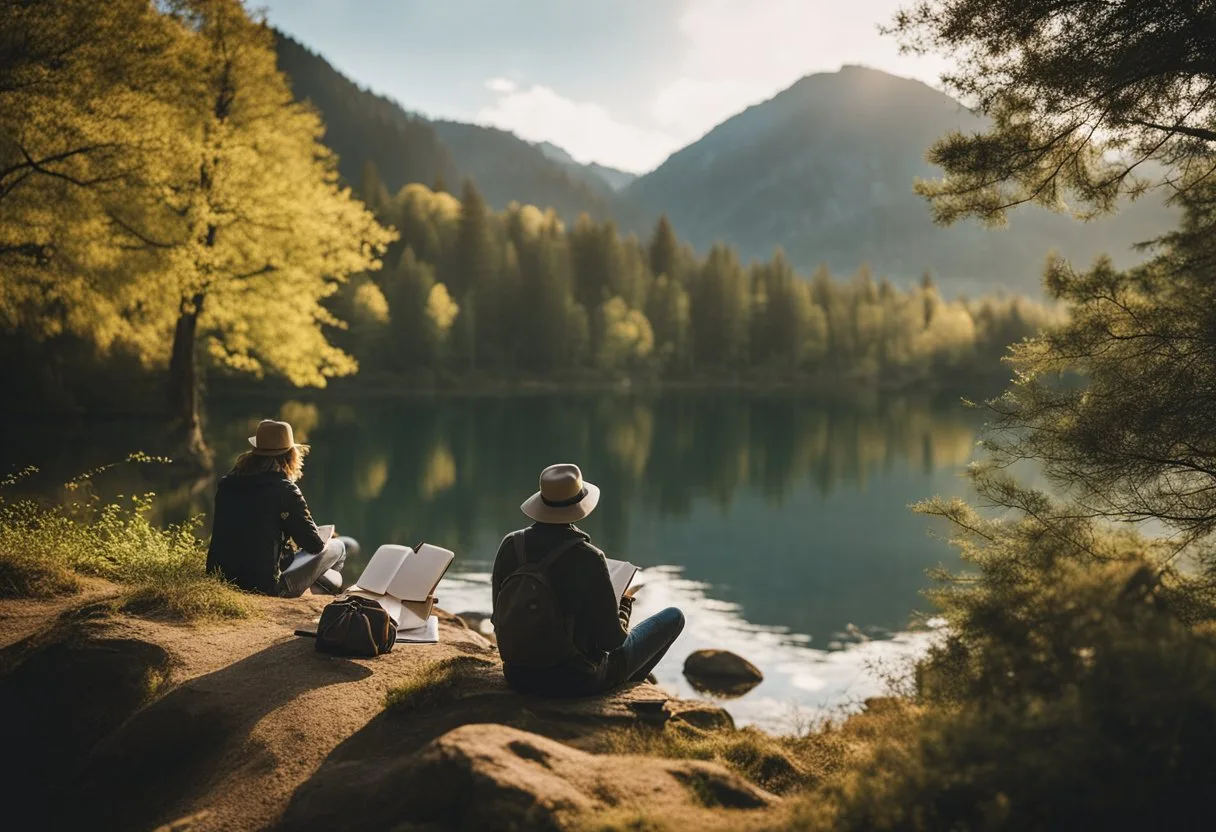Nature journaling is a creative way to connect with the natural world and record observations in a personal and meaningful way. It is a way to document the beauty of nature and reflect on the experiences that come with spending time outdoors. Nature journaling can be done in various forms, including writing, drawing, painting, and photography. In this blog post, I will share with you 55 nature journaling ideas for capturing the magic of nature and tips for getting started.
Observation is a key element in nature journaling. It involves taking the time to notice the details of the natural world, such as the colors, textures, shapes, and sounds of plants and animals. By observing the natural world, one can gain a deeper understanding of the interconnections between different species and ecosystems. Nature journaling provides a way to document these observations and reflect on their significance.
Art is another important aspect of nature journaling. It allows one to express their creativity and capture the beauty of nature in a unique and personal way. Drawing or painting in a nature journal can also help improve one’s artistic skills and provide a sense of accomplishment. Nature journaling can be a therapeutic and relaxing activity that promotes mindfulness and a deeper appreciation for the natural world.
Getting Started with Nature Journaling
Nature journaling is a wonderful way to connect with the natural world and record your observations and experiences. Here are some tips to get started with nature journaling:
Choosing Your Tools and Materials
To begin nature journaling, you do not need much. All you need is a journal and a pen or pencil. However, if you want to make it more enjoyable, you can invest in some special supplies. Some of the commonly used materials for nature journaling include:
- Watercolor pencils
- Colored pencils
- Watercolor paints
- Fine-tip pens
- Sketchbook
Understanding the Basics of Observation
Observation is the foundation of nature journaling. To be a good observer, you need to use all of your senses and pay attention to the details. You can practice your observation skills by:
- Taking a walk in nature and observing the plants, animals, and landscapes around you
- Focusing on one object and observing it closely
- Sketching what you see to help you notice more details
Setting Goals and Intentions
Setting goals and intentions can help you stay motivated and focused in your nature journaling practice. Some goals you can set include:
- Recording the changes in a specific plant or animal over time
- Observing a particular ecosystem and noticing the interactions between different species
- Documenting your personal growth and mindfulness through nature journaling
Remember, nature journaling is a practice that takes time and dedication. By setting goals and intentions, you can stay inspired and track your progress.
55 Nature journaling ideas
- Observe the behavior of a specific animal over several days.
- Sketch the different stages of a blooming flower.
- Record the sounds you hear in a forest and describe them.
- Collect leaves from different trees and press them in your journal.
- Photograph a landscape and write about the changes you notice over time.
- Measure the growth of a plant or tree each week.
- Draw the insects you find on a nature walk and research their species.
- Listen to and describe the different bird calls you hear in the morning.
- Write a poem inspired by a natural feature, like a mountain or river.
- Paint a scene using watercolors directly in your journal.
- Note the different types of clouds you see and what weather follows.
- Track the moon phases and their effect on your mood or the environment.
- Observe and document the patterns of stars on a clear night.
- Write about the experience of sitting quietly in a natural setting.
- Illustrate the ripples in a pond or stream.
- Record the date and details of the first snowfall of the season.
- Sketch the footprints of animals and try to identify them.
- Document the colors of the sunset at the same location over a week.
- Describe the textures and smells of different plants and soils.
- Count the number of bird species you see in a day.
- Draw a map of your favorite hiking trail and mark interesting features.
- Listen for and describe the sounds of different weather conditions.
- Write a detailed description of a rock or mineral you find.
- Illustrate the life cycle of a frog from tadpole to adult.
- Collect and describe the different seeds you find in the fall.
- Observe the changes in a caterpillar as it transforms into a butterfly.
- Sketch the bark patterns of various trees and note their species.
- Record the water levels of a stream or lake throughout the year.
- Write about the feelings you experience while watching a sunrise.
- Paint the petals of flowers, focusing on their delicate details.
- Describe the sensation of walking barefoot on different natural surfaces.
- Illustrate the patterns made by leaves or branches against the sky.
- Record the different fungi you encounter and their locations.
- Sketch the silhouette of a mountain range or hill.
- Observe and document the behavior of bees around flowers.
- Note the changes in your garden or a park with each passing season.
- Write about the impact of human activity on a natural area you visit.
- Document the first signs of spring you observe in your area.
- Illustrate the waves at the beach, noting their size and rhythm.
- Record the types of fish you see in a clear body of water.
- Sketch the arrangement of petals on various flowers.
- Describe the sounds and sights during a rainstorm.
- Observe and note the behavior of ants or other insects.
- Draw the patterns of frost on windows or plants.
- Record your thoughts while sitting by a fire outdoors.
- Illustrate the different shapes of snowflakes you observe.
- Describe the process of a leaf changing color in autumn.
- Note the flight patterns of birds migrating in the fall or spring.
- Sketch the shadows cast by the sun at different times of the day.
- Record the appearance and behavior of nocturnal animals you spot.
- Write about the experience of exploring a new natural environment.
- Document the blooming and wilting of a flower.
- Observe the interactions between different species in an ecosystem.
- Illustrate the different stages of the moon as seen from your location.
- Note the variety of animal life around a body of water like a pond or stream.
- Describe the changes in a forest as you walk from edge to interior.
- Record the sounds of a city park and how they differ from a rural setting.
Exploring the Natural World
Nature journaling is a wonderful way to explore and document the natural world. By taking the time to observe and record the flora and fauna around you, you can deepen your understanding and appreciation of the world we live in. Here are some ideas for exploring and documenting the natural world in your nature journal.
Documenting Flora and Fauna
One of the most rewarding aspects of nature journaling is documenting the plants and animals you encounter. Use your journal to sketch and describe the different species you see, noting their unique characteristics and behaviors. You can also record the locations where you find them, and any interesting facts you learn about them.
Observing Weather and Seasons
Another important aspect of nature journaling is observing the weather and seasonal patterns. Keep track of the temperature, humidity, and pressure, and note any changes you observe over time. You can also record the different weather conditions you experience, such as rain, snow, or wind, and how they affect the natural world around you.
Capturing Landscapes and Scenery
Finally, use your nature journal to capture the landscapes and scenery around you. Sketch the trees, flowers, and other plants you see, noting their colors and textures. You can also draw the different landscapes you encounter, from mountains and forests to beaches and deserts. By documenting the natural world in your journal, you can develop a deeper connection to the outdoors and the world around you.
Nature journaling offers a unique way to explore and document the natural world. By documenting the flora and fauna, observing the weather and seasons, and capturing the landscapes and scenery, you can deepen your understanding and appreciation of the natural world.
Creative Expression and Reflection
Nature journaling is a unique way to connect with the natural world, and it offers a wide range of benefits that extend beyond artistic expression. The practice of nature journaling involves recording personal experiences and observations in a journal, often incorporating art, writing, and storytelling techniques.
Incorporating Art and Creativity
One of the most significant benefits of nature journaling is the opportunity to express creativity through art. Whether it’s through drawings, sketches, or painting, incorporating art into a nature journal can help individuals connect with nature in a more profound way. Art can also be a powerful tool for self-expression and reflection, allowing individuals to explore their emotions and thoughts in a creative way.
Writing and Storytelling Techniques
Nature journaling also offers an opportunity to improve writing and storytelling skills. Descriptive writing, poetry, and personal reflection are all techniques that can be incorporated into a nature journal.
Through storytelling, individuals can reflect on their experiences in nature and share their stories with others. This can be a powerful way to connect with others and inspire them to explore nature themselves.
Personal Growth and Mindfulness
Finally, nature journaling can also be a tool for personal growth and mindfulness. By taking the time to reflect on personal experiences in nature, individuals can gain a deeper understanding of themselves and their relationship with the world around them. Mindfulness techniques, such as deep breathing and meditation, can also be incorporated into nature journaling, providing an opportunity for stress relief and overall well-being.
Nature journaling is a unique practice that offers a wide range of benefits, including creative expression, improved writing and storytelling skills, and personal growth and mindfulness. By incorporating art, writing, and storytelling techniques into a nature journal, individuals can connect with nature in a more profound way and gain a deeper understanding of themselves and the world around them.
Advancing Your Nature Journaling Practice
Nature journaling is a practice that can be developed over time with patience, repetition, and dedication. Once you have established a foundation of basic skills, there are several ways to advance your nature journaling practice.
Developing Advanced Observation Skills
Observation is the foundation of nature journaling. The more you observe, the more you will learn about the natural world and the more detailed and accurate your journal entries will become. To develop advanced observation skills, it is important to practice regularly and to ask questions. For example, you might ask yourself: What are the patterns in the natural world? How do different species interact with each other? What is the role of weather in the ecosystem?
Engaging with the Nature Journaling Community
Engaging with the nature journaling community is a great way to learn from others and to get feedback on your work. There are many online communities and local groups dedicated to nature journaling, such as John Muir Laws and Henry David Thoreau societies. Attending field trips and outdoor adventures with other nature journalers can also be a great way to learn and to connect with like-minded individuals.
Exploring Further and Teaching Others
Once you have developed a solid foundation of nature journaling skills, you may want to explore further and teach others. There are many resources available for learning how to teach nature journaling, such as books, online courses, and workshops. Teaching others can be a rewarding way to share your passion for nature and to inspire others to connect with the natural world.
Advancing your nature journaling practice involves developing advanced observation skills, engaging with the nature journaling community, and exploring further and teaching others. With practice and dedication, anyone can become a skilled nature journaler and deepen their connection with the natural world.
Frequently Asked Questions
What are some effective prompts for starting a nature journal as an adult?
Starting a nature journal as an adult can be intimidating, but there are many effective prompts to get you started. Some popular prompts include recording the weather, identifying and drawing plants and animals, and writing about your personal experiences in nature. You can also try using creative prompts like writing a poem about a particular landscape or drawing a map of a hiking trail you’ve explored.
How can one benefit from incorporating nature journaling into their routine?
Nature journaling can have many benefits, including increased mindfulness, improved observation skills, and a deeper appreciation for the natural world. Nature journaling can be a therapeutic activity that helps reduce stress and anxiety. Incorporating nature journaling into your routine can also provide a sense of accomplishment and satisfaction as you build a record of your experiences in nature.
What are the key elements to include when creating a nature journal template?
When creating a nature journal template, it’s important to include sections for recording the date, location, and weather conditions. You should also include space for writing observations and reflections, as well as areas for drawing or sketching plants and animals. It can also be helpful to include sections for recording scientific data, such as temperature and humidity readings.
Can you suggest methods for organizing content within a nature journal?
Organizing content within a nature journal can be a personal choice, but there are some effective methods to consider. One approach is to organize content by location or habitat, while another is to organize by date or season. You can also group content by theme, such as recording different types of birds or plants. Whatever method you choose, it’s important to keep your journal organized and easy to navigate.
What activities are typically involved in nature journaling classes or workshops?
Nature journaling classes or workshops can involve a variety of activities, including guided hikes, drawing and sketching exercises, and writing prompts. Some classes may also include instruction on scientific observation and data collection. These classes can be a great way to connect with other nature enthusiasts and learn new skills.
When is International Nature Journaling Week and what events typically occur?
International Nature Journaling Week typically occurs in June and is a celebration of nature journaling around the world. During this week, nature journaling workshops and events are held in many different locations, and participants are encouraged to share their work on social media using the hashtag #NatureJournalingWeek. The week typically includes activities like guided hikes, drawing sessions, and writing workshops.




